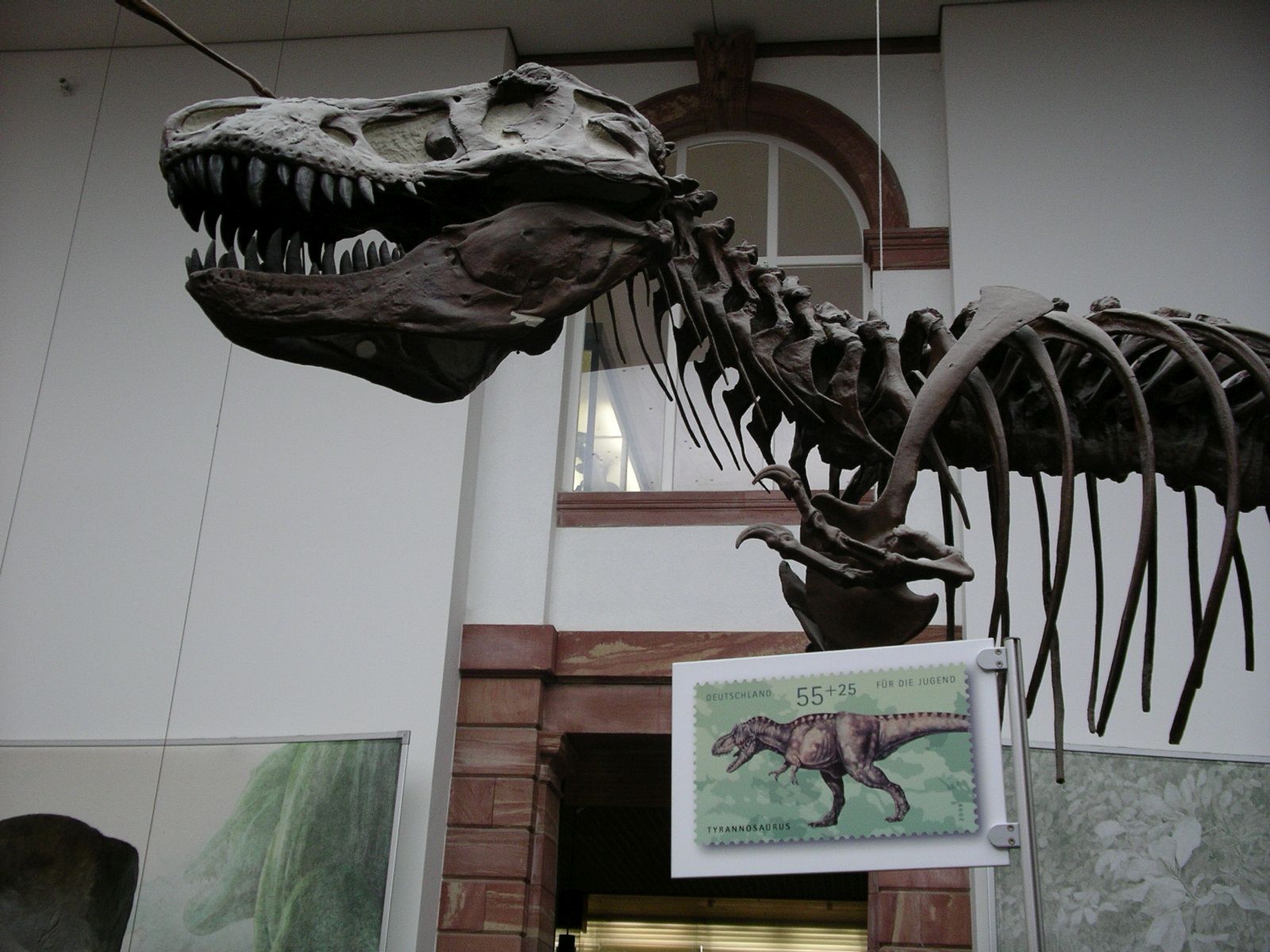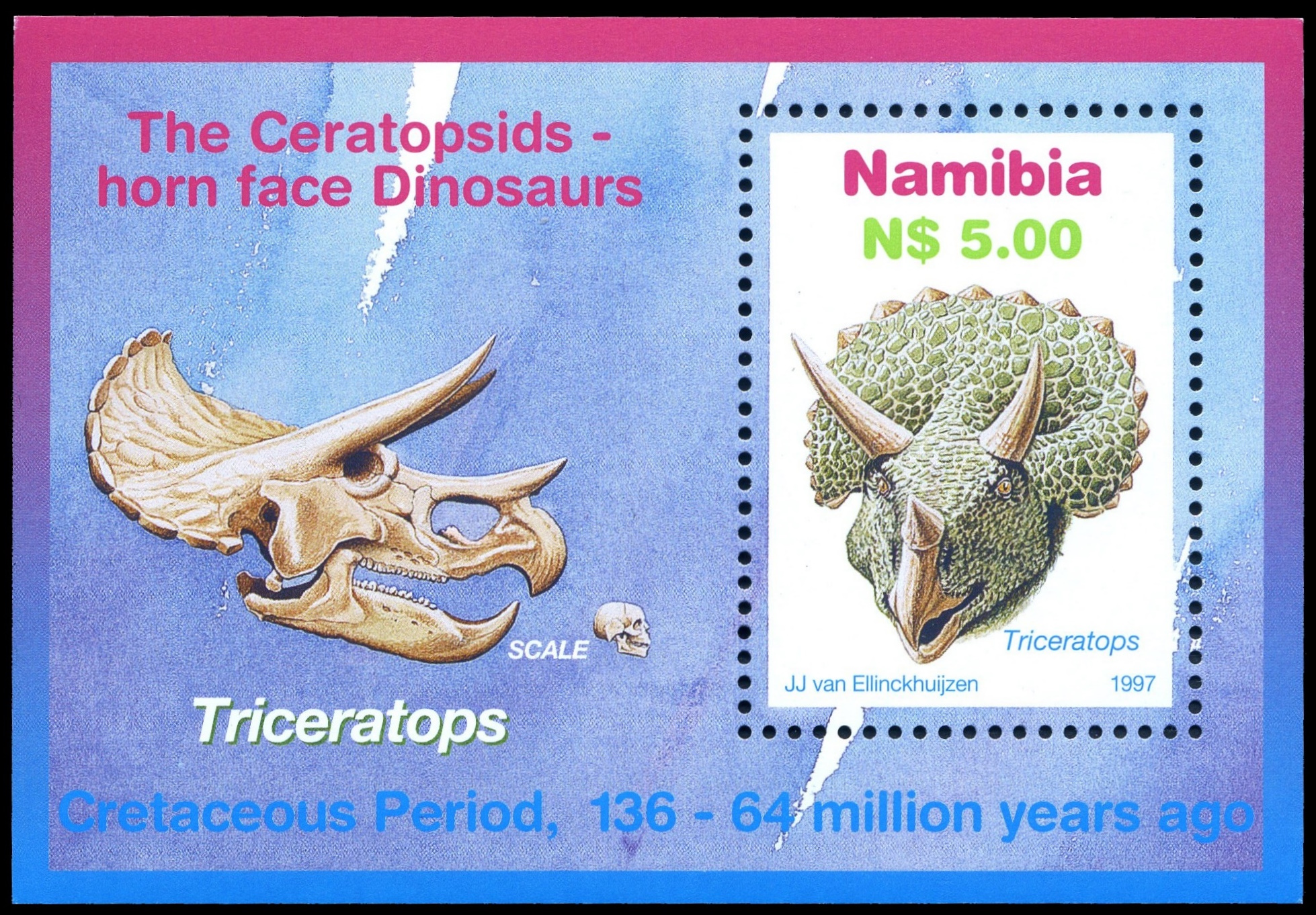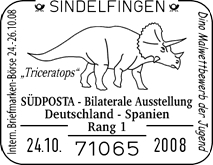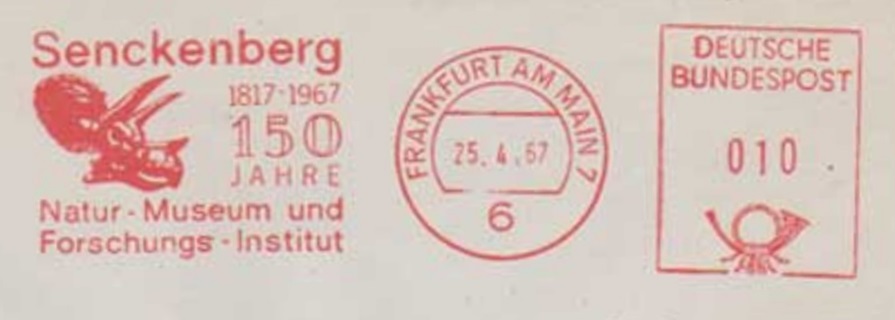Germany 2008 "For the Youth - Dinosaurs"
| <prev | back to index | next> |
| Issue Date | 04.09.2008 |
| ID | Michel: 2687-2690, Bl. 73; Scott: 1007a-d; Stanley Gibbons: MS3558; Yvert et Tellier: 2512-2515; Category: pR |
| Design | Werner Hans Schmidt, Germany - stamps of
Diplodocus,
Tyrannosaurus,
Plateosaurus + both post marks Joe Tucciarone from Science Photo Library, UK - stamp of Triceratops |
| Stamps in set | 4 |
| Value | €0,45 + €0,20 - Triceratops €0,55 + €0,25 - Diplodocus €0,55 + €0,25 - Tyrannosaurus €1,45 + €0,55 - Plateosaurus Total postage value: €3, total donation value: €1,25. |
| Emission/Type | commemorative, semi-postal |
| Issue places | Berlin, Bonn |
| Size (width x height) | 55,00 x 32,80mm (each stamp) 110,0 x 190,0mm (Block) |
| Layout | MS of 4 stamps |
| Products | FDC x1, PS x1 |
| Paper | stroke, white, fluoresce, special post paper DP 2 |
| Perforation | 13,25 x 13,25 |
| Print Technique | Multicolor offset print |
| Printed by | Giesecke & Devrient GmbH, Wertpapierdruckerei Leipzig |
| Quantity | 1,350,000 Mini-Sheets |
| Issuing Authority | The Federal Ministry of Finance (Deutsche Post AG) |
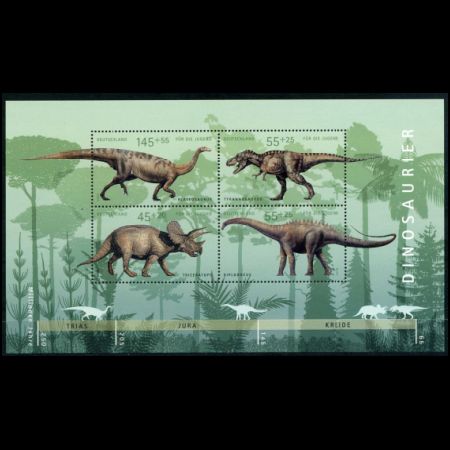
On September 4th, 2008, the Postal Authority of Germany, Deutsche Post AG put into circulation the Mini-Sheet of four "Dinosaurs" stamps.
The dinosaurs represent reconstructions of fossils from the collection of the Natural History Senckenberg (in German Naturmuseum Senckenberg ) in Frankfurt am Main.
A large part of each animal’s tail is outside the margins of its stamp, extending into the selvage of the souvenir sheet.
These semi-postal stamps were inscribed "FÜR DIE JUGEND" (in English "For the Youth"). The value before "+" is the postage rate of a domestic postcard (45c), domestic small letter up to 20gr. (55c) and domestic large letter up to 500gr. (145c).
The value after "+" is a donation to "Die Stiftung Deutsche Jugendmarke e.V." (in English "the German Youth-Stamps Foundation"), who issued an extra set of FDC with single stamps from the Mini-Sheet. Every FDC comes with a booklet with details about the Foundation and the dinosaurs depicted on the stamps.
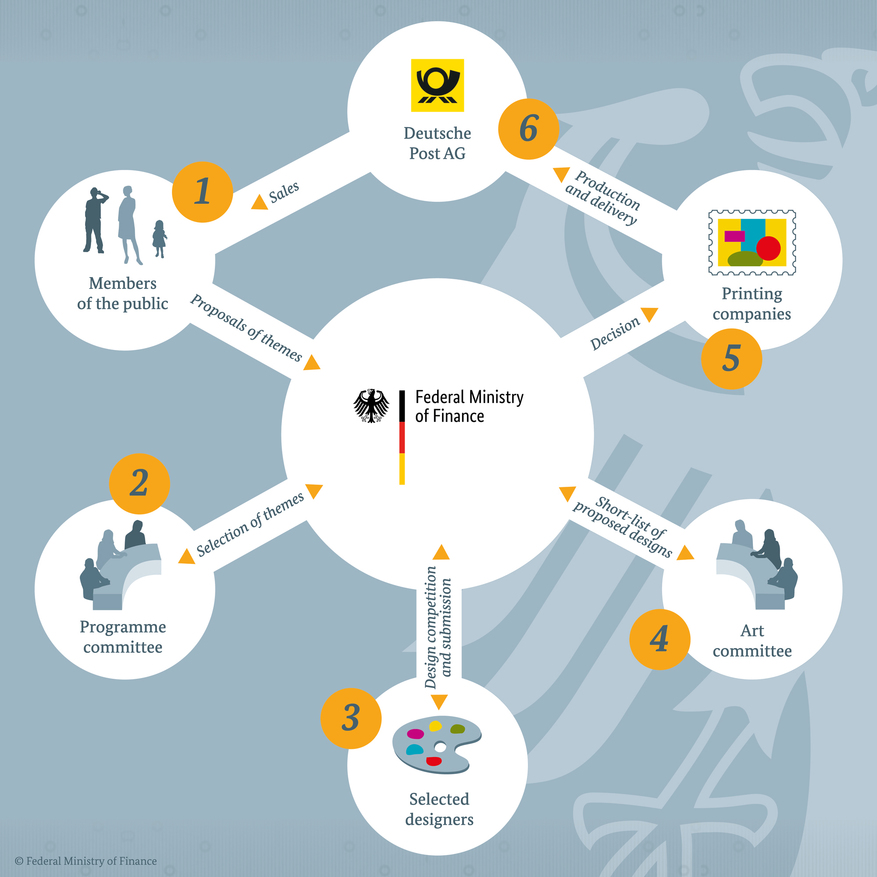 |
| Creation process of German postage stamps. Image credit: German Federal Ministry of Finance |
Since 1965,
"die Stiftung Deutsche Jugendmarke e.V. (in English "the German Youth-Stamps
Foundation"), under the chairmanship of the Federal Minister responsible for
youth, has managed the surcharge proceeds from the sale of the
“For the Youth” (in German für die Jugend) plus
stamps issued annually by the Federal Ministry of Finance.
This supports projects by recognized independent and public child and youth welfare
providers.
The funding focus is on projects that have an innovative and forward-looking
character and enable new paths in child and youth welfare.
The issue Authority of the German postage stamps is the Federal Minister of Finance,
as the Deutsche Post, the successor to the German mail authority Deutsche Bundespost,
was privatized in 1995 and became a fully independent company in 2000.
The Ministry acts not only as the highest German revenue authority, but, by
issuing stamps, the Ministry also plays a role in chronicling contemporary German
history and supporting charities in Germany.
Since 1998, it is the German Finance Minister who decides on the design of stamps
on the basis of a clearly defined set of criteria.
In making this decision, the Minister is supported by two advisory committees.
The German Finance Ministry runs design competitions for its special-edition
postage stamps and works with a pool of graphic designers for this purpose.
The Post Authority (Deutsche Post) is responsible for the stamps sales only.
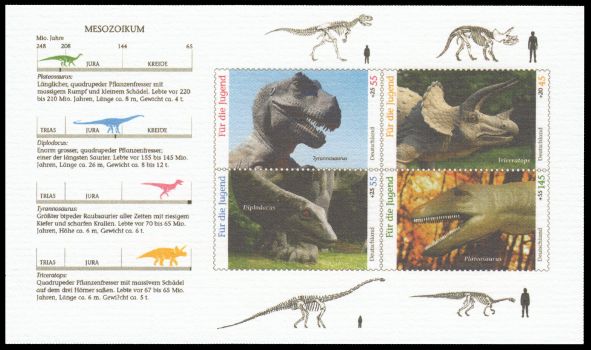 |
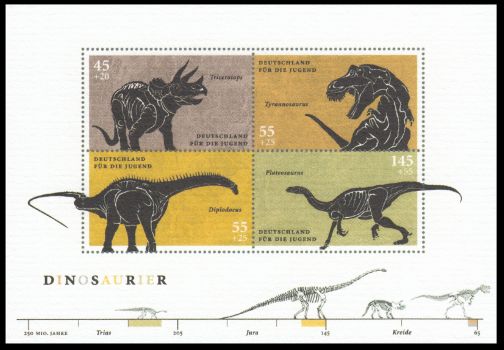 |
| The draft of Gerhard Lienemeyer | The draft of Ingo Wuff |
At the end of the competition, the Art committee of German Federal Ministry of Finance selected three images of German artist Werner Hans Schmidt from Frankfurt am Main, and the Triceratops image of Joe Tucciarone from the Science Photo Library company in the UK. The Mini-Sheet of dinosaur stamps was designed by Mr. Werner Schmidt in consultation with Dr. Gerhard Winter, the head of Education Department of the Senckenberg Natural History Museum.
It features as motifs The Plateosaurus is the only of the four dinosaurs who roamed the territory of modern Germany. The other three dinosaurs lived in North America. Their skeletons, original or casts, were donated to or purchased by the museum.
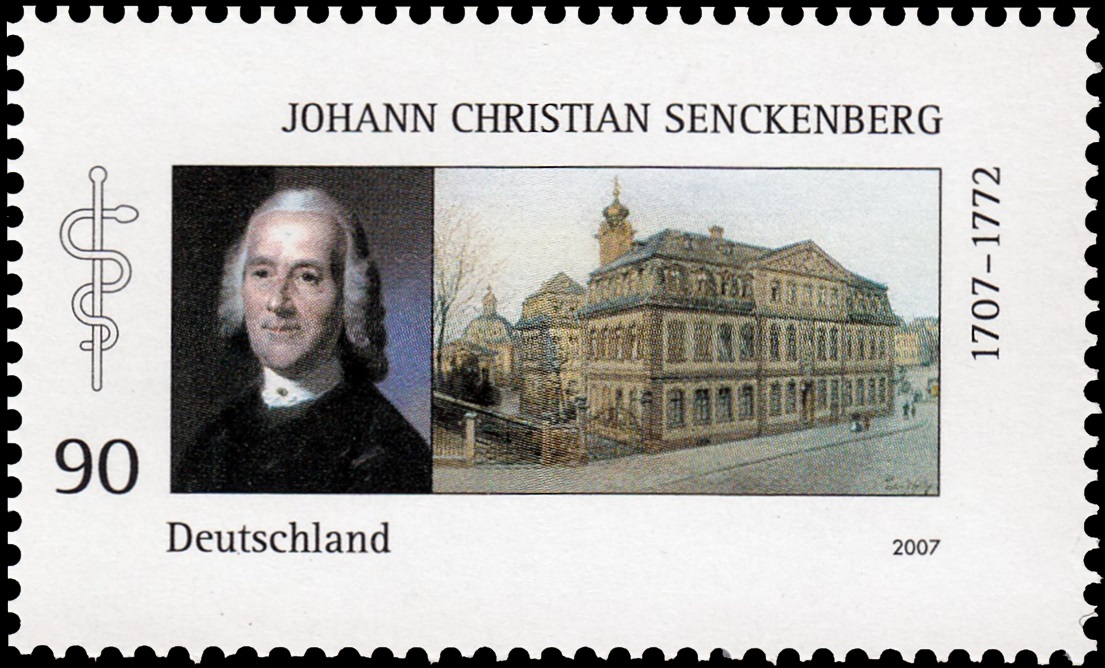 |
| Johann Christian Senckenberg on stamp of Germany 2007 |
The "Naturmuseum Senckenberg" (in Englishh Senckenberg Natural History Museum) is
a museum of natural history, located in Frankfurt am Main,
in the state of Hesse of Germany.
It is the second largest of its kind in country.
In 2010, almost 517,000 people visited the museum, which is owned by the Senckenberg Nature Research Society.
As of 2019, the museum exhibits 18 reconstructed dinosaurs.
In 1817, 32 Frankfurt citizens founded the non-profit Senckenberg Nature Research Society,
in German: Senckenberg Gesellschaft für Naturforschung (SGN), which is a member of the Leibniz Association today.
The Society was named after Johann Christian Senckenberg
(1707-1772) who donated 95,000 guilders, his entire fortune, to establish a
community hospital and promote scientific projects in 1763.
Soon after, Johann Georg Neuburg donated his collection of bird and mammal specimens to the society.
The Naturmuseum Senckenberg was founded in 1821, just four years later.
Initially located near the Eschenheimer Turm, the museum moved to a new building on Senckenberganlage in 1907.
During World War II, the building was partly destroyed.
However, the exhibits had been evacuated before.
Today the Senckenberg Museum Frankfurt has a large collection of animal,
plant and geology exhibits from every epoch of Earth's history.
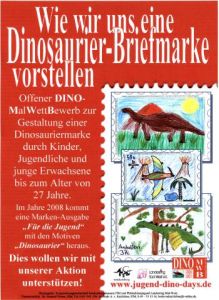 |
| Announcement of "DINO - Painting Competition 2006/2007" |
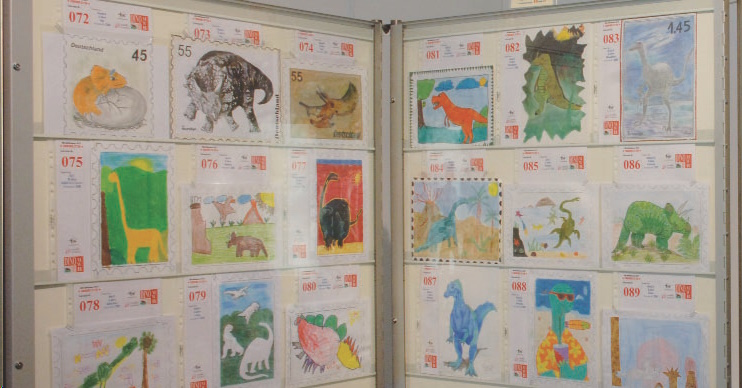 |
| Some of the drawings were displayed during the "Dino-Party"
in the Senckenberg Natural History Museum, on September 6th 2008. Image credit: "Senckenberg 2007-2008" brochure of the Museum. |
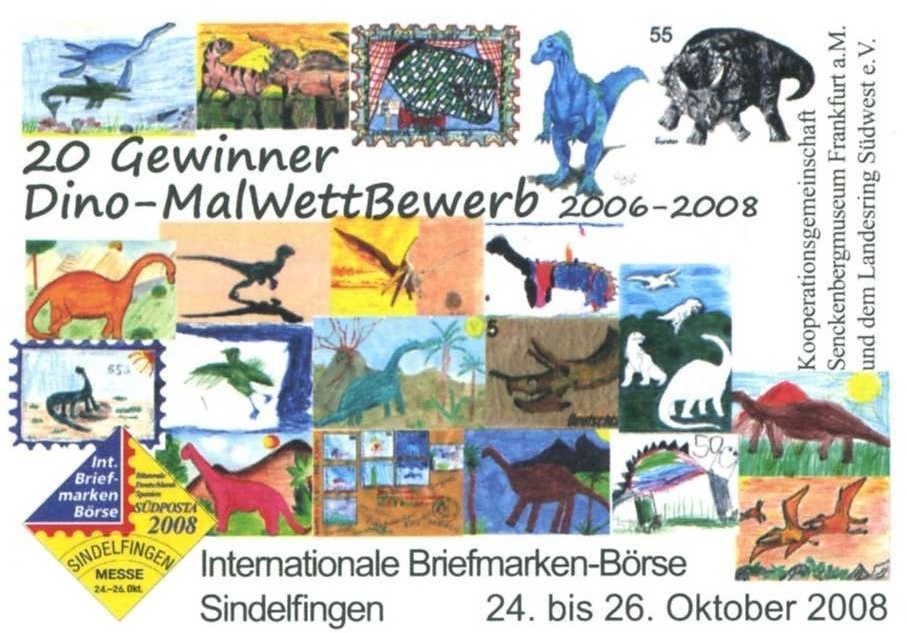 |
| The cachet of the postal stationery |
 |
| The book of Deutsche Post |
These stamps were the first dinosaur stamps issued by the Post of the Federal Republic of Germany. The dinosaur skeletons stamps from 1990 were issued by German Democratic Republic.
At the end of October 2006 at the annual stamp trade show in Sindelfingen (near to Stuttgart), the Senckenberg Nature Museum in Frankfurt am Main and the south-western German young people’s philately association “Landesring Süd-West” organized "DINO Days 2006" adventure park, which occupied almost 500 m2 of the trade show area. During this event they launched "DINO - Painting Competition 2006/2007".The campaign moto was "How we imagine a dinosaur stamp / Design your own dinosaur stamp". The organizers of this painting competition wanted to support this nationwide DINO painting competition, which is designed as an “open painting competition”.
All children, teenagers and young adults up to the age of 27, as well as school classes, youth groups and/or youth communities, were eligible to participate. The DINO painting competition ended on August 31, 2007.
Of the 3.531 entries, 110 made it to the final round. The announcement of the winner and the award ceremony took place in the festival room on September 6th, 2008, in the Senckenberg Nature Museum in Frankfurt am Main.
Anyone who wanted to develop a feeling as a researcher and excavator was able practice excavation field, where to search for hidden treasures in the "desert sand" to dig for fossils.
The Films and listening corner provided some insight to whom wanted to learn about dinosaurs and other prehistoric creatures, before visit "DINOJUBRIA 2006" philatelic show and exponats competition.
Among the youth philatelist, some special guests displayed their exhibits (not for competition).
- Dr. Gerhard Winter from the Senckenberg Nature Museum: "Dinosaurier auf den Marken der Welt" (in English "Dinosaurs on stamps of the World")
- Mrs. Michaela Kohlhagen: "Saurier Geheimnisvolle Urzeittiere" (in English: “Dinosaurs mysterious prehistoric animals”)
- Fran Adams from San Diego/USA: "The Complete T-rex"
To provide a good start for the youth philatelist into "Dinosaurs in Philately" topic, two German philatelic clubs issued colorful, soft-cover brochures. These brochures were offered at the stamp presentation at the Senckenberg Nature Museum on September 5th 2008. Today they can be downloaded from the website of the German Philatelic Society, in PDF format.
-
"Saurier, Geheinmisvolle Urzeittiere"
(in English "Dinosaurs mysterious prehistoric animals"),
written by Michaela Kohlhagen from the Youth Philatelists club of
the German Philatelic Association.
The 72 pages, soft-cover brochure with illustrations and brief descriptions of many dinosaur stamps and postmarks. -
"Bildung + Briefmarke, Thema Dinosaurier"
(in English "Education + Stamps, topic Dinosaurs"), written by Rudolf Hofer
from
Arbeitsgemeinschaft Bergbau Und Geowissenschaften e. V
(in English Mining and Geosciences Working Group).
The 48 pages, soft-cover brochure with details about dinosaur evolution and rich illustrations by international stamps.
"Deutsche Philatelisten-Jugend e.V." in English the Youth Philatelists club of the German Philatelic Association (in German Bund Deutscher Philatelisten) organized many events for children in 2008 where the dinosaur stamps and some philatelic exhibits with dinosaur stamps were presented.
Deutsche Philatelisten-Jugend e.V.,
in English German Youth Philatelists club, is dedicate to support young
philatelist with age between 6 and 20.
The club issue „Junge Sammler“ (in English "Young Collector") magazine,
help to the youth collectors to make their exhibits and organize annual meetings
and special events in several locations of Germany.
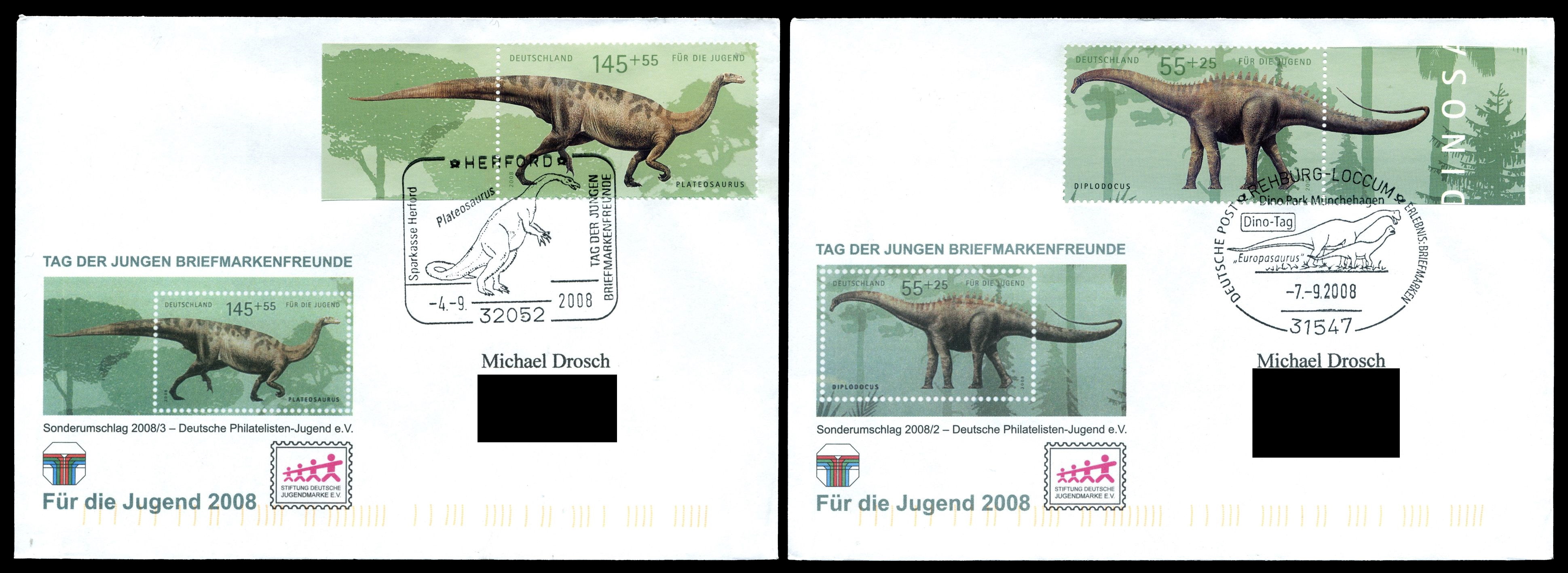
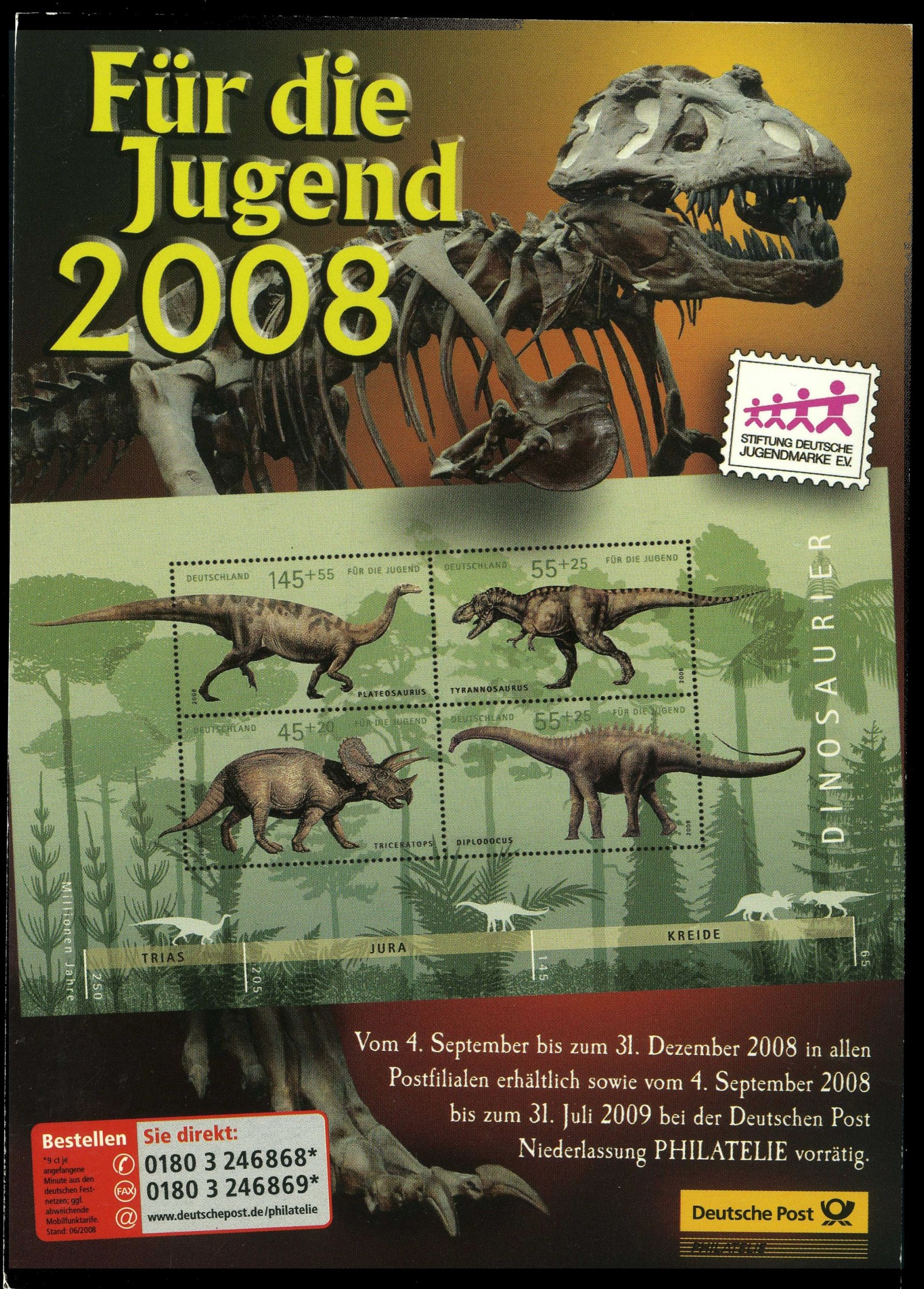 |
Above:
Commemorative covers with two dinosaur stamps from the Mini-Sheet, produced by Deutsche Philatelisten-Jugend e.V. in 2008. Plateosaurus stamp on the left cover, was cancelled by the postmark designed for the meeting of the Youth club in Herfold.
On the right:
Promotional postcard of Deutsche Post that informed collectors about the issue of dinosaur stamps, which are going to be on sale in all Post Offices from September 4th to December 31st 2008, then at PHILATELIE desks, till July 31st 2009.
On Friday, September 5th, 2008, (the day after the sale of the stamps started in the post offices around Germany) the official inauguration of the stamps by the Parliamentary State secretaries of the Finance and Family Ministries took place in the Dinosaur Hall of the Senckenberg Natural History Museum in Frankfurt am Main, at the state of Hesse of Germany.
During the ceremony the Parliamentary State Secretary of the Federal Minister of Finance Mrs. Nicolette Kressl handed over Ministery Booklet with first printings of the stamps to, among others,
- Dr. Hermann Kues, Parliamentary State Secretary to the Federal Minister for Family, Senior Citizens, Women and Youth
- Dr. Volker Mosbrugger, Director of the Senckenberg Research Institute and Nature Museum
- Norbert Kartmann, President of the Hessian State Parliament
- Volker Hoff, Minister for Federal and European Affairs and Representative of the State of Hesse to the Federal Government
Enlarged images of the stamps were displayed next to the dinosaur skeletons in the Museum.
Mr. Werner H. Schmidt, the artist from Frankfurt am Main, who designed 3 of the 4 stamps of the Mini-Sheet, held autograph session during the presentation.
Due to the fact, Mr. Schmidt attended many philatelic events, during 2008, related to the dinosaur stamp and held a autograph sessions there, it is not difficult to find the Mini-Sheet or a cover signed by him, on the market.
One day later the museum threw a big dino-party in honor of the German Post Office’s first dinosaur stamps. Over 2.000 guests, large and small, were in attendance, busily painting dinosaur ceramics, creating their own prehistoric reptiles, marvelling over 30 centimeters long Tyrannosaurus teeth at the Discoverers’ Table and gazing through binoculars. Collectors could purchase a commemorative postmark at a special post office.
 |
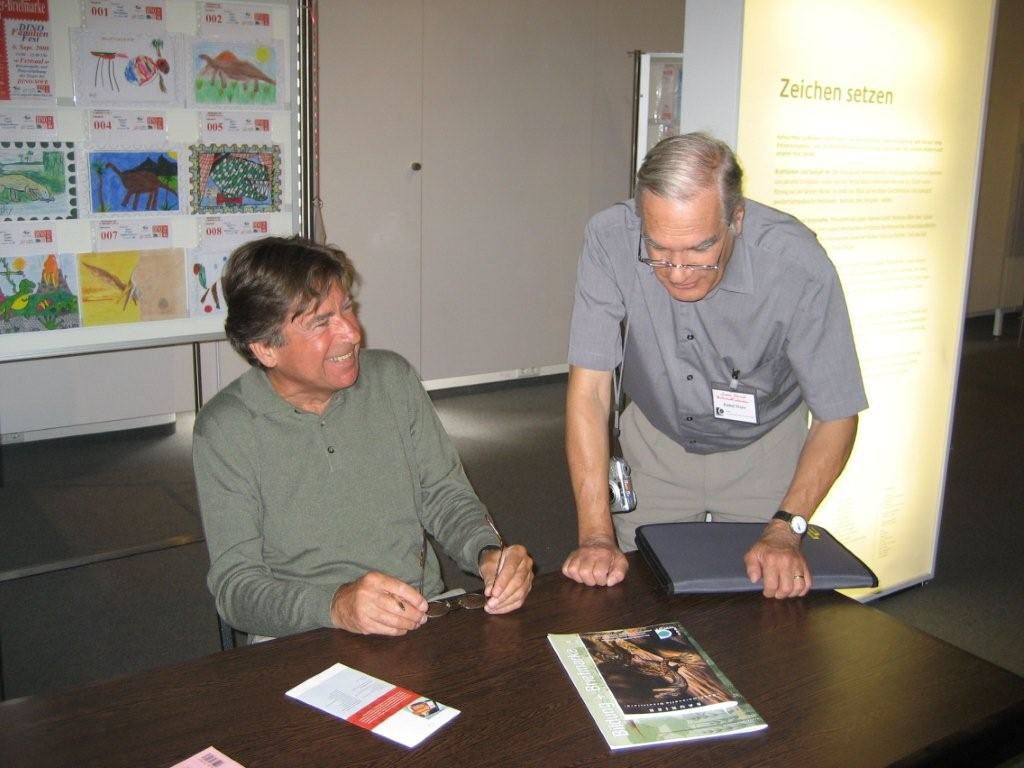 |
|
Big Dino-Party in the Senckenberg Natural History Museum, on September 6th 2008. Image credit: "Senckenberg 2007-2008" brochure of the Museum. |
Mr. Werner H. Schmidt (on the left) with Mr. Rudolf Hofer on the autograph session during the stamps presentation
in the Senckenberg Natural History Museum, on September 6th 2008. The photo was provided by Mr. Rudolf Hofer. |
The following text is based on the translation from the German text written by Lena Schmidt from Natural History Senckenberg, Frankfurt am Main which was attached to FDC covers of "the German Youth-Stamps Foundation", with some notes added by the author of the website.
Triceratops - the "three-horned face".
Triceratops belongs to the order of "bird-hipped" dinosaurs (Ornithischia), and the family of horned dinosaurs (Ceratopsidae), who lived during the Late Cretaceous Period.
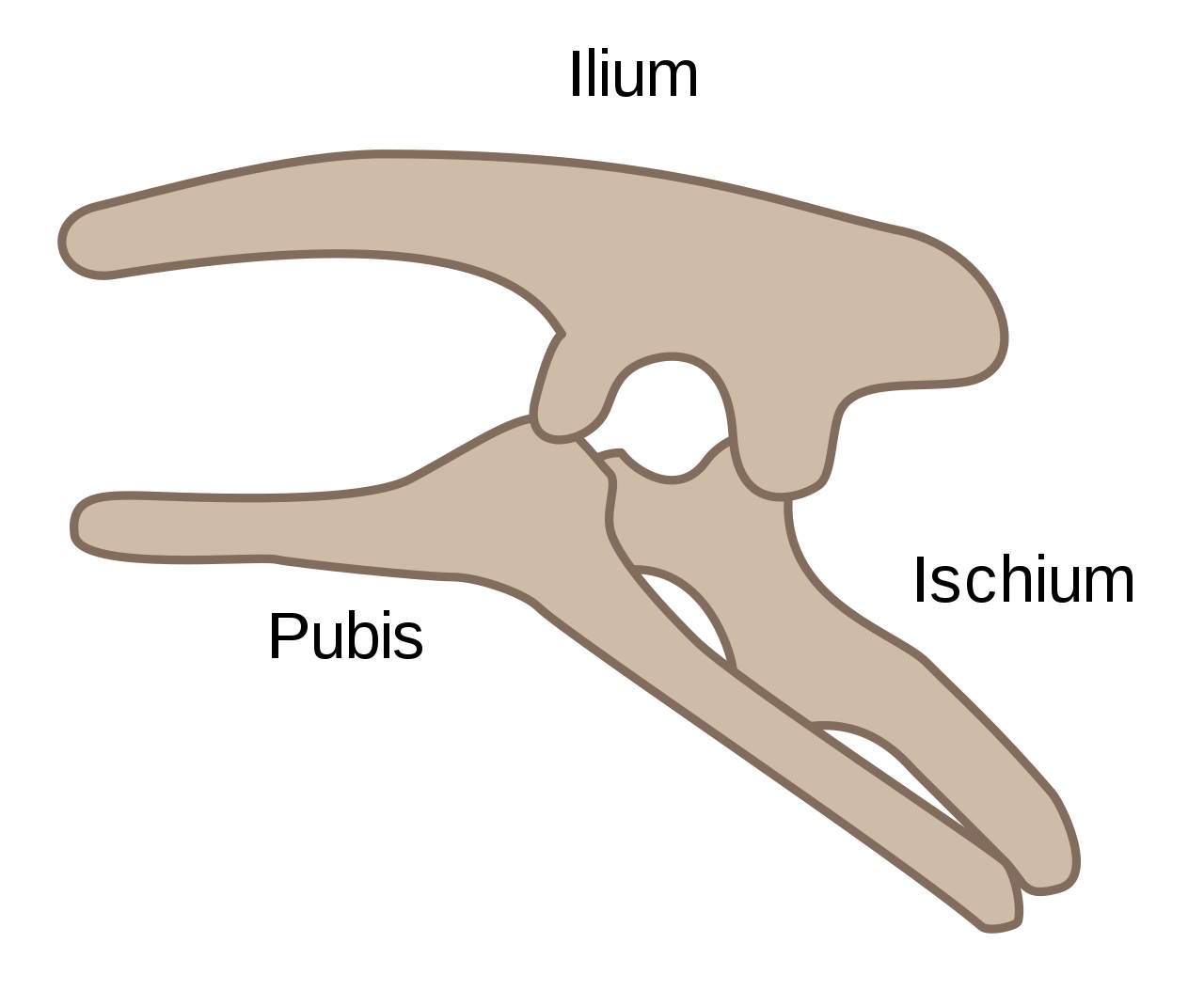 |
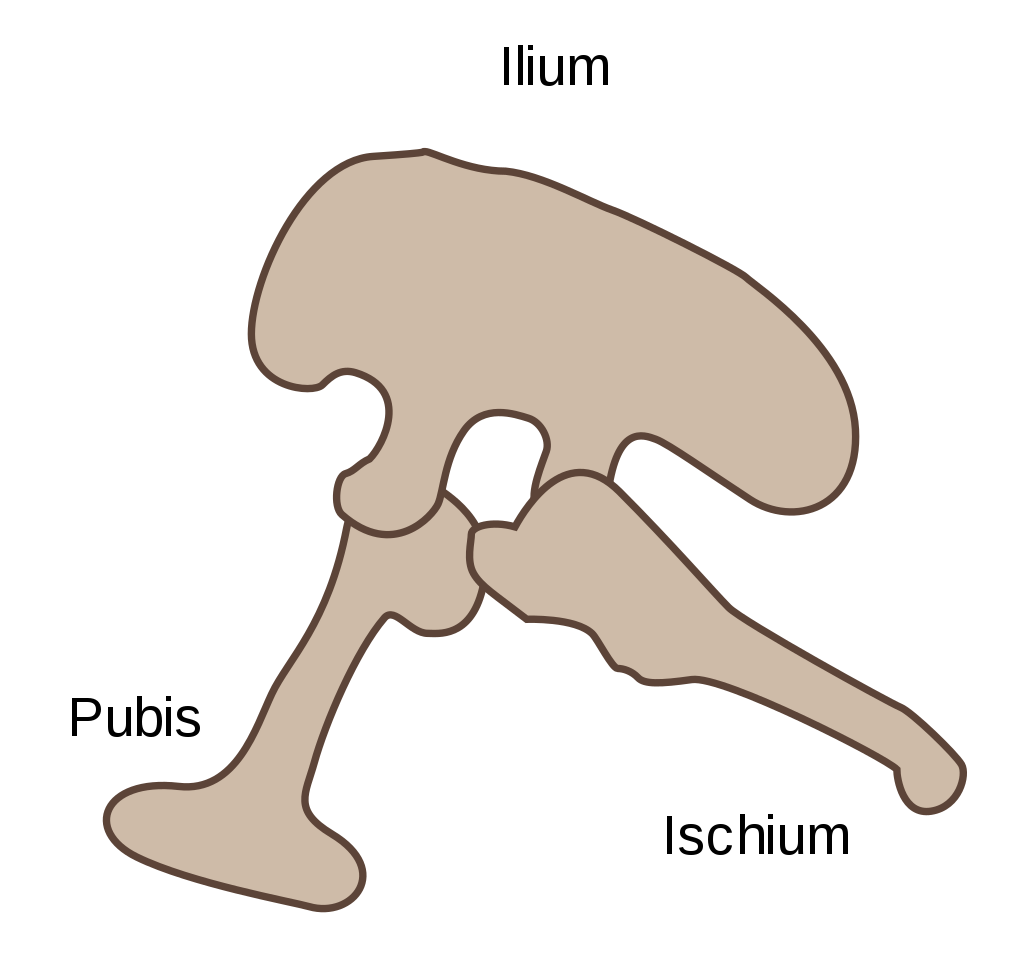 |
| Dinosaurs pelvic structure: left - Ornithischian ("bird-hip"), right - Saurischian ("reptile-hipped"). Image credit: Wikipedia | |
Triceratops was carried the largest and heaviest skull in its family (Ceratopsidae). It appeared about 70 million years ago and disappeared together with all non-avian dinosaurs 65 million years ago.
Its massive, barrel-shaped body could grow up to 9 meters long and its weight is estimated at up to 9 tons. It was carried primarily by the powerful hind legs, which suggests that he wasn't a particularly fast runner.
The most impressive is certainly his huge skull, which he also gave his name “tree-horned face". He had two bony horns, up to a meter long above his eyes and the third one on the snout. The horns were covered with a stratum corneum during life. They served as his defence against hungry predatory dinosaurs.
The huge, wide bony neck frill, also immediately catches the eye.
- The first assumption suggests that it was intended to protect the sensitive neck in combat with large predators. There are some Triceratops that bear tooth marks of a Tyrannosaurus, that support this theory.
- On the other hand, the frill had strongly branched grooves in which there were blood vessels. Thereby ensuring good blood flow to the shield could also provide a heat-regulating function. The large frill may have helped to increase body area to regulate body temperature.
- The third theory states, that the blood circulation causes the shield to turn reddish and thus could be used as a deterrent against predators or rivals. Some of the fossil skulls show injuries that could have resulted from rank disputes.
Severely worn teeth fell out over time and were immediately replaced with replacement teeth.
Unlike other dinosaurs the Triceratops had fleshy cheeks and could therefore grind food in its mouth for longer.
Like many other herbivorous dinosaurs, Triceratops had to swallow stones, so called stomach stones or gastroliths. These stones remained in the muscular gizzard and used to grind food, so that the nutrients could be extracted from them.
Paleontologists can only speculate about the social behaviour of dinosaurs. Some foot traces and huge fossil sites of Triceratops indicate that the animals lived and moved in large herds. Special arrangements of the tracks also show that adult dinosaurs took their young animals into the middle of attacks and formed a so-called "carriage fort" around them.
Note: The Natural History Senckenberg in Frankfurt am Main has two original skulls of Triceratops, purchased from fossil collector Charles Hazelius Sternberg and his sons in the early 20th century.
The museum also exhibits a cast of a complete Triceratops, constructed from bones of four individuals.
The Triceratops skull was selected by the museum as "heraldic" symbol, and appears on meter frankings, postmarks and decorations of museum's letters.
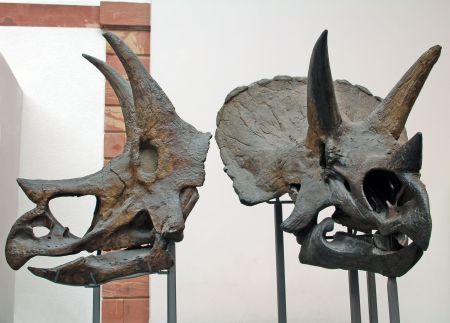 |
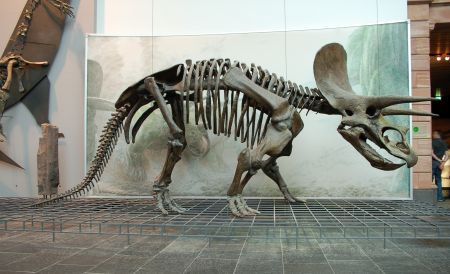 |
| The skulls of Triceratops and cast of Triceratops skeleton on display in the Natural History Senckenberg in Frankfurt am Main. Image credit: Wikipedia [1], [2] | |
Tyrannosaurus - “tyrant lizard”.
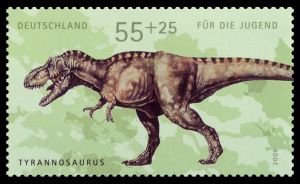 |
| Tyrannosaurus rex on stamp of Germany 2008 MiNr.: 2688, Scott: B1007c. |
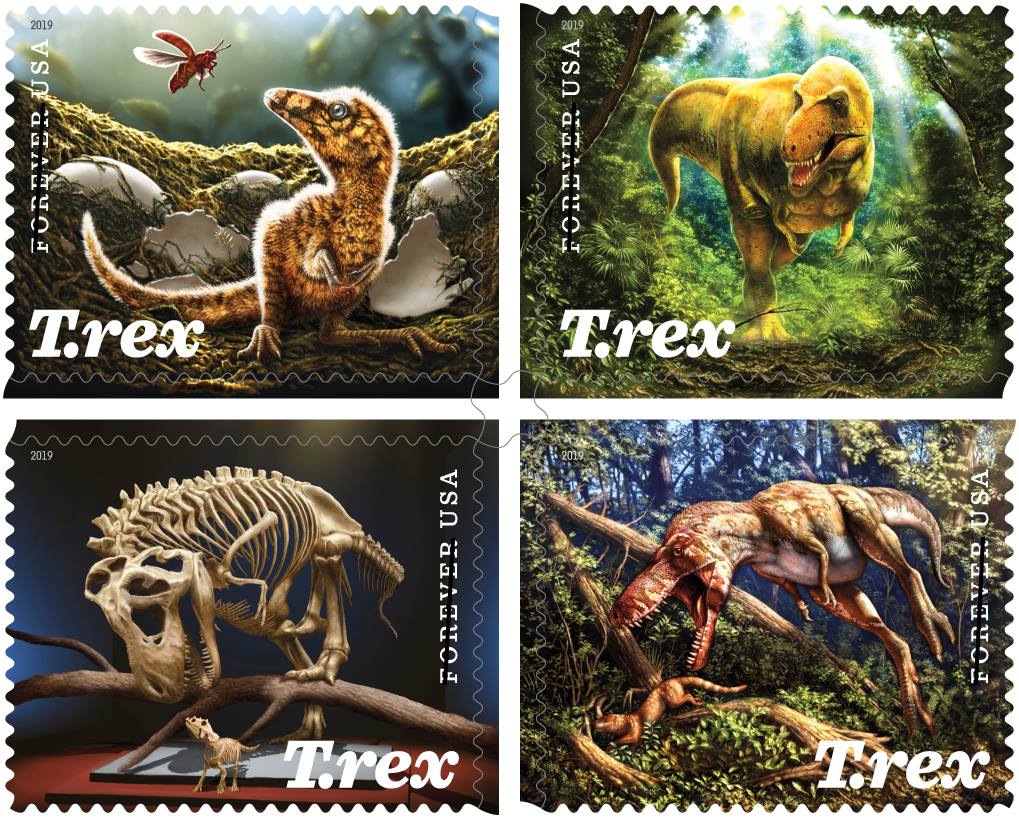 |
| Tyrannosaurus rex stamps of USA 2019, MiNr.: 5647-5650, Scott: 5413. |
 |
| Tyrannosaurus on postmark of Germany 2008 |
Fossils of Tyrannosaurus-like dinosaurs (tyrannosaurids) were found in western North America and Asia.
With a length of up to 13 meters and a weight of around 6 tons, it was one of the largest predators that ever lived on land.
Like all carnivorous dinosaurs, Tyrannosaurus walked on its hind legs, which were strong and muscular, but not necessarily particularly fast.
Recent (2008) research has shown that the muscle attachments on the legs do not necessarily indicate that the Tyrannosaurus was a nimble runner. This puts his image of the mercilessly fast, bloodthirsty hunter into perspective and suggests that he also did not disdain carcasses.
The three broad toes with the sharp claws are sometimes an indication that theropods like Tyrannosaurus are ancestors of today's birds.
The short, thin arms represent a strong contrast to the stately legs of the Tyrannosaurus. The arms end up with only two claws. It is not yet clear what function they served. They probably served as a support when standing up after the dinosaur had rested or slept.
In the mouth of the tyrant lizard there were up to 58 pointed teeth with finely ribbed edges, roots could grow up to 30 centimetres long. He also owes the nickname “Sharp tooth” to them, because he could use them to tear pieces of flesh out of prey. Broken teeth were quickly replaced by new ones that grew up from below.
The eye sockets of tyrannosaurs are positioned so that the eyes would point forward and due to the narrow snout, giving them binocular vision. This helped for the better estimating distances when hunting other dinosaurs.
Whether a skeleton of a Tyrannosaurus is a female or a male animal can be determined in comparison with a group of reptiles that are still alive today, the crocodiles. In female crocodiles, the lower vertebral process (hemal arch) of the first caudal vertebra are smaller than the following vertebrae and thus offers more space for the passage of eggs. This anatomical special has also been noted in some Tyrannosaurus finds and they are therefore considered females.
Furthermore, there was a discovery of five Tyrannosaurus skeletons lying side by side in Montana, USA, suggesting that Tyrannosaurus was common in the Upper Cretaceous, lived in hunted in packs.
Note: The Tyrannosaurus rex skeleton in the Senckenberg is a complete copy of a dinosaurs in the American Museum of Natural History in New York. It is a gift, made by BHF-Bank in 1991 for 70th birthday of Dr. Hanns-Christian-Schroeder-Hohenwarth, Honorary President of the Senckenberg Society for Nature Research.
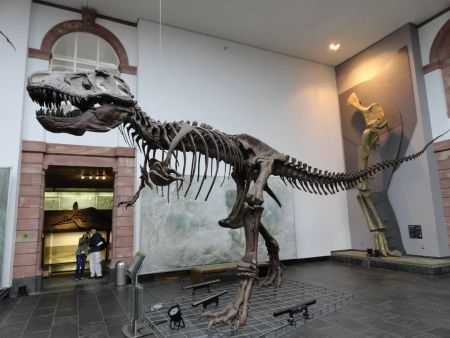 |
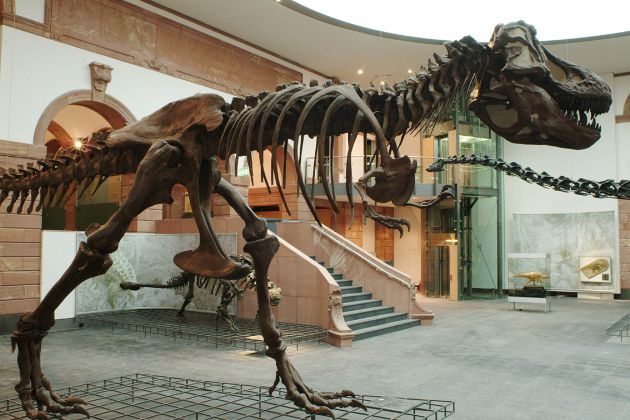 |
|
Tyrannosaurus rex skeleton on display in the Natural History Senckenberg in Frankfurt am Main. Image credit: the Fossil Forum, the Natural History Senckenberg in Frankfurt am Main |
|
Diplodocus - "Long-necked, double-barred"
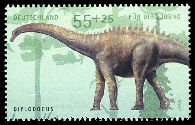 |
| Diplodocus dinosaur on stamp of Germany 2008 MiNr.: 2690, Scott: B1007b. |
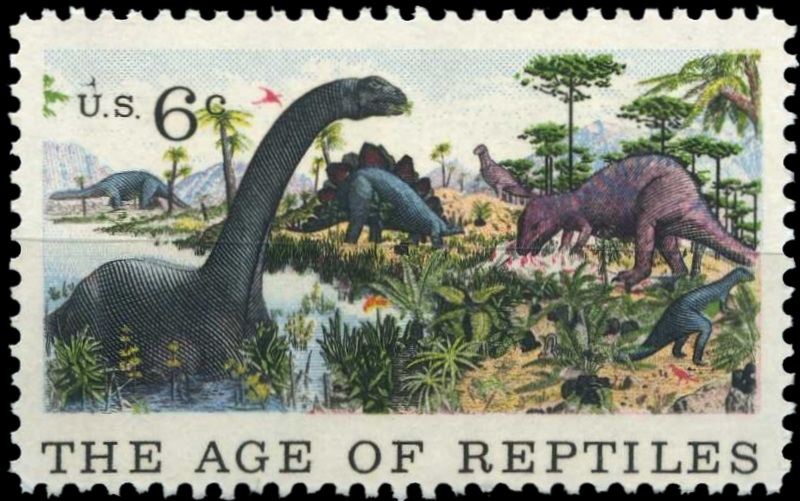 |
| Diplodocus on stamp of USA 1970 MiNr.: 1002, Scott: 1390. |
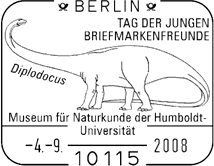 |
| Diplodocus on postmark of Germany 2008 |
The double bars refer to a pair of chevrons that run along the length of each tail vertebra. This structure helps make the tail more rigid.
Diplodocus is systematically classified in the order of lizard-hipped dinosaurs (Saurischia) and suborder of lizard-footed dinosaurs (Sauropoda), the giants of the Mesozoic, and the largest land-dwelling animals that have probably ever existed on Earth.The herbivorous Sauropods, including Diplodocus, lived during the Jurassic period, around 155-145 million years ago.
The slender body, the whip-shaped tail and the long, horizontal seemingly tiny skull of Diplodocus are typical features of the Sauropods.
At up to 28 meters long, the Diplodocus is the longest complete dinosaur found (at least to the date of the stamp issue). Its height was up to 5 meters and its weight was around 8-10 tons.
In the past, paleontologists estimated an even bigger weight, but the latest scientific studies suggest, that there were air-filled tissue bubbles in the cavities of the cervical and trunk vertebrae. These bubbles could reduce the body weight of the Diplodocus by up to 20% and even increase stabilization of the long neck. The dinosaur could, probably, hold the neck horizontally, move it up and down, as well as left and right without much effort, which gives him an idea "grazing" of large plants was made possible.
The tail of the Diplodocus, which was also very long, served as a counterweight to the neck, but perhaps that could also be used for defence, like a whip. The large skin surface, the neck and tail together were used by the dinosaur to release excess energy body heat.
With the pin-like teeth, which were only located in the front area of the jaw, he plucked needles and fern leaves from branches like with a rake and gobbled them straight down.
For crushing the plant the Diplodocus probably regularly swallowed stones, so-called gastroliths or stomach stones, to grind up the food before sending it to the stomach for digestion.
A rare discovery of fossilized skin casts made in 1992 shows that the Diplodocus had horn spikes up to 30 centimetres long along the back from head to tail.
Furthermore, fossilized footprints provide evidence that the Diplodocus and its relatives were widespread in the Jurassic Period and roamed in larger herds, with larger animals being the protecting the group outside.
Note:
The 18 meters mounted Diplodocus, original skeleton in the museum, was discovered in Bone Cabin Quarry, Wyoming, USA. It was donated by director of the American Museum of Natural History Mr. Morris Ketchum Jesup on the occasion of the present museum building's inauguration on 13 October 1907.
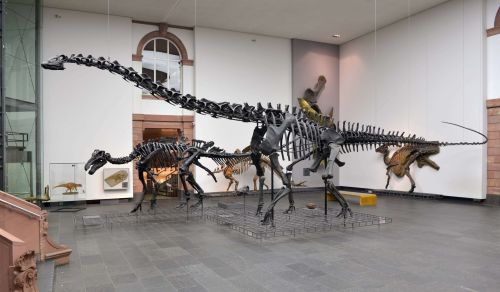 |
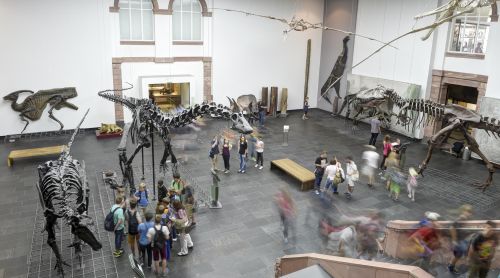 |
|
Diplodocus in the middle of Dinosaurs Hall in the Natural History Senckenberg in Frankfurt am Main. Image credit: website of the Natural History Senckenberg in Frankfurt am Main |
|
The Plateosaurus - the "broad lizard".
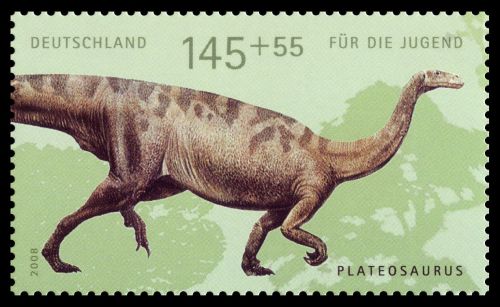 |
| Plateosaurus dinosaur on stamp of Germany 2008 MiNr.: 2687, Scott: B1007d |
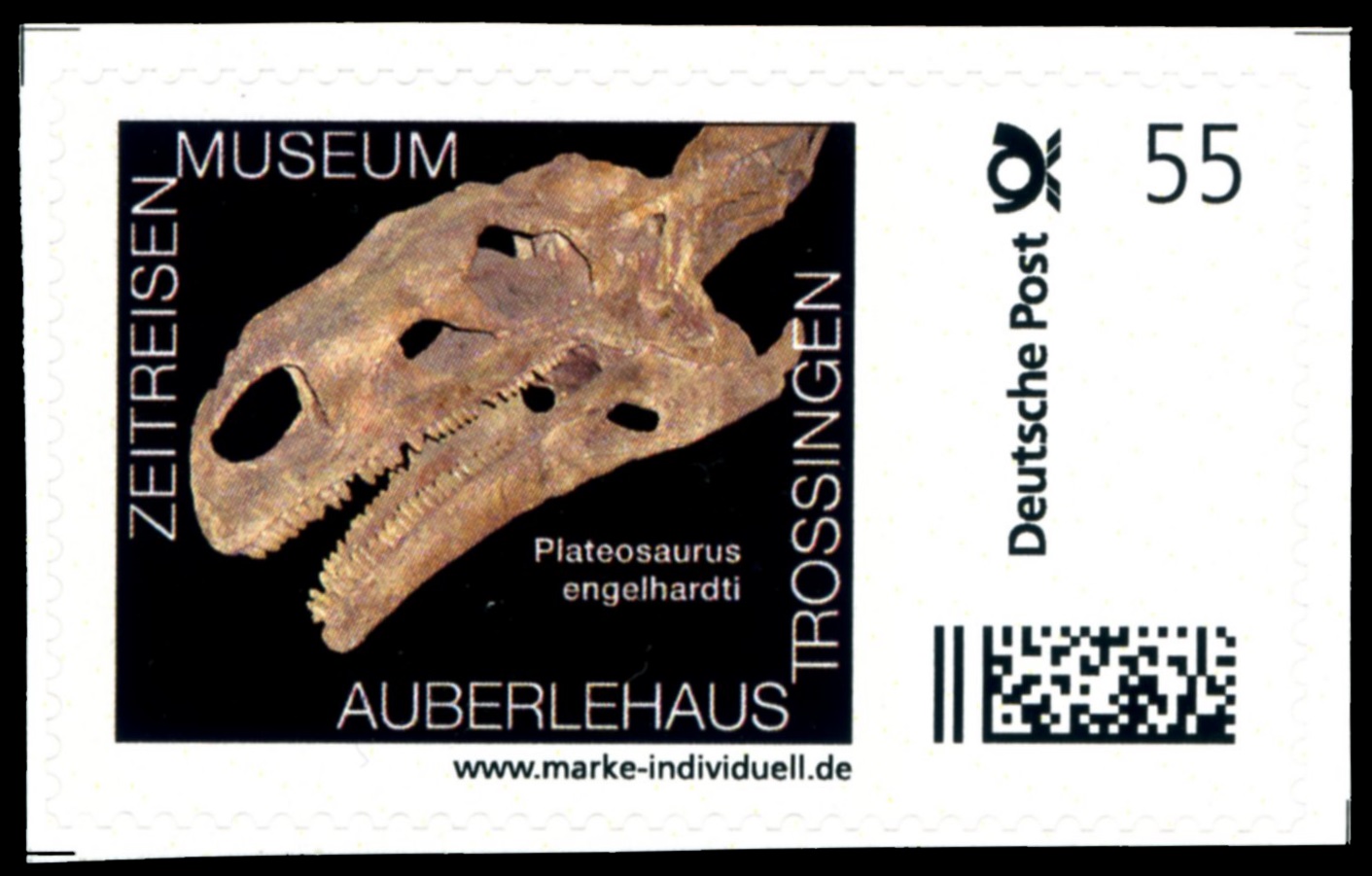 |
| Plateosaurus skull on personalized stamp of Germany 2010 |
 |
| Plateosaurus on postmark of Germany 2008 |
The is the oldest of the dinosaurs presented on the stamps. The dinosaur lived around 220-210 million years ago during the Late Triassic period. Systematically, like the Diplodocus, Plateosaurus belongs to the order of reptile-hipped dinosaurs (Saurischia), the group of early herbivores known as the pre-lizard-footed dinosaurs or "prosauropods" (an early group that might have been ancestral to the giant sauropod dinosaurs of later time periods).
The herbivore was one of the largest dinosaurs in the Triassic, with a body length of around 6 meters and a weight of around 2 tons.
Its fossils were discovers in several places in Germany, as well as in some other locations across Europe.
Already in the 19th century, extensive finds were discovered in Baden-Württemberg, Franconia and Saxony regions of Germany, indicated that Plateosaurus was common in its time and probably lived in herds. It was named by a German scientist: the Frankfurt's paleontologist Hermann von Meyer. Von Meyer described it in 1837 as Plateosaurus engelhardti. The specific name is after the Nuremberg doctor Friedrich Engelhardt, who found the bones near Nuremberg in 1834.
In 1830 Hermann von Meyer in the magazine “Isis” describes the previously known dinosaurs (Megalosaurus and Iguanodon) as a separate group among reptiles as “saurs with limbs similar to those of the heavy land mammals".
This definition was used by Richard Owen in 1841 when he coined the name "Dinosauria" for this group.
To this day, the ones standing vertically under the body are still used hind legs as the typical feature for dinosaurs.
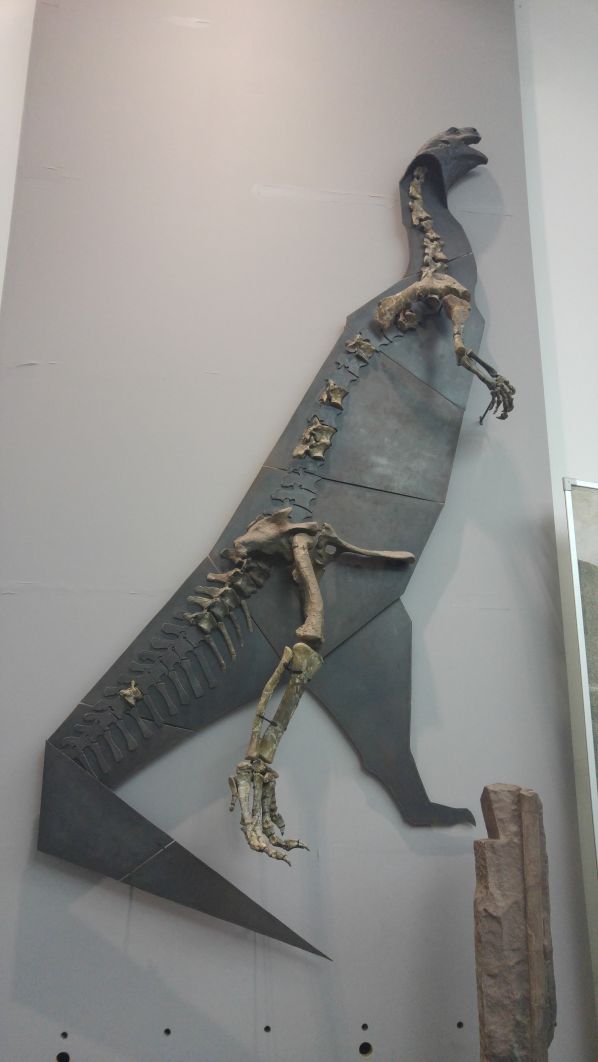 |
| Original skeleton of Plateosaurus engelhardti on the wall in the Dinosaurs Hall in the Natural History Senckenberg in Frankfurt am Main. The skeleton was discovered in Halberstadt, Germany Image credit: the Fossil Forum |
Due to the large numbers of Plateosaurus fossils discovered between 1911 and 1932 in Trossingen, Swabia region, the nickname "Schwäbischer Lindworm" (in English Swabian lindworm or Swabian dragon) was given to the dinosaur, although it was distributed worldwide.
Like other prosauropods, Plateosaurus had a long neck, a small head and an elongated, barrel-shaped body. His legs were strong and stocky and his tail was powerful and heavy.
Scientists have long debated whether the dinosaur walked on two or four legs. The hind legs were long and strong, but its broad forelimbs were also capable of supporting part of the body weight. This and also the structure of the bones led to the opinion that the Plateosaurus was more of a four-legged walker, but was able to sit up comfortably while eating and pick up leaves with his little ones plucking teeth from trees.
Like all herbivorous dinosaurs, Plateosaurus could not chew plant matter but instead used gastroliths (stomach stones) to grind up the food before sending it to the stomach for digestion.
He actually used the large, sharp claws on the thumb and second toe of the Plateosaurus to ward off predatory dinosaurs, but perhaps also to dig up roots or something else plant parts.
Note:
Most Plateosaurus fossils, discovered between 1911 and 1932 in Germany, found their way to the Museum für Naturkunde in Berlin and the Naturaliensammlung in Stuttgart (predecessor to the State Museum of Natural History Stuttgart), where many of them were destroyed during World War II.
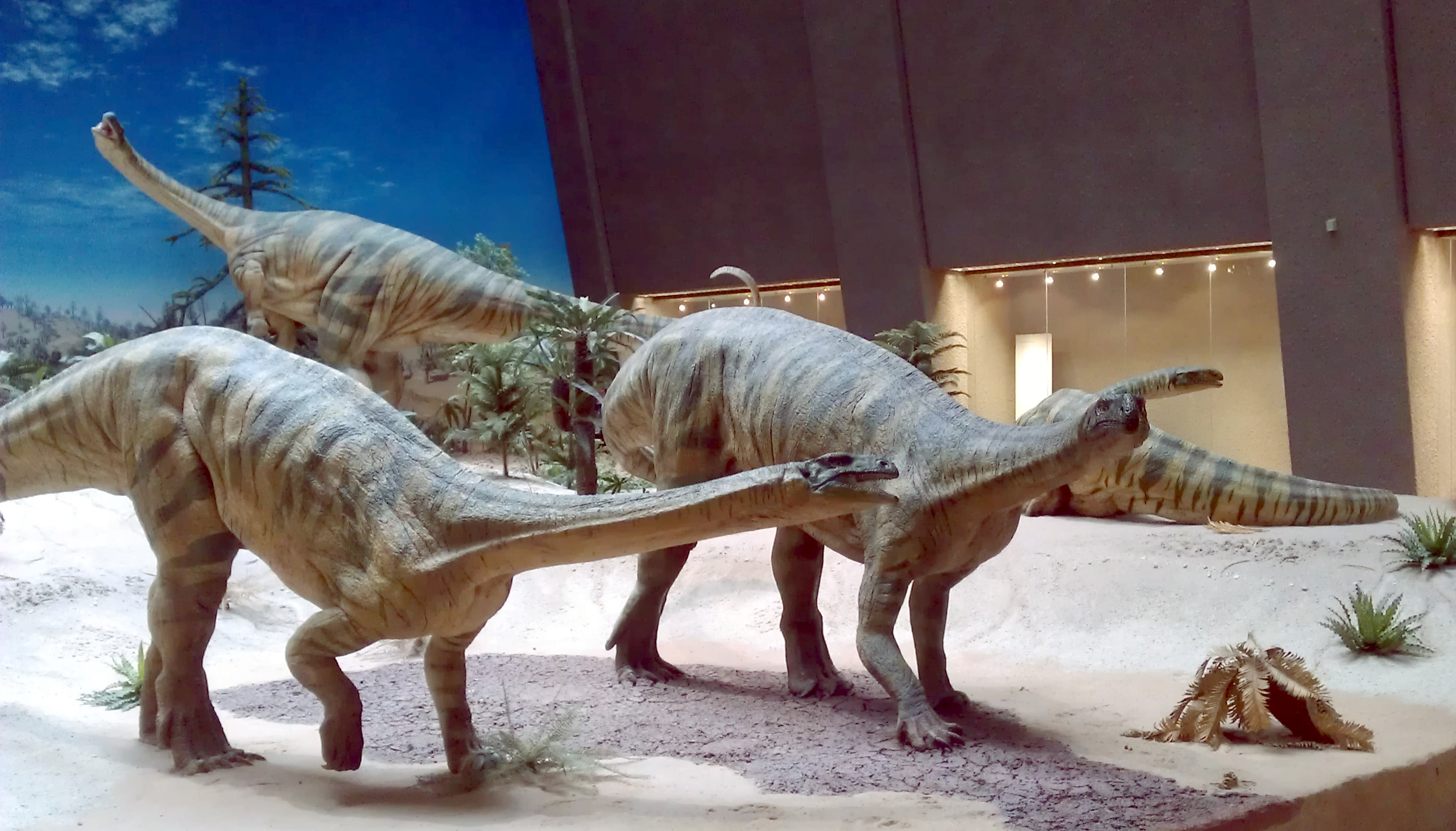 |
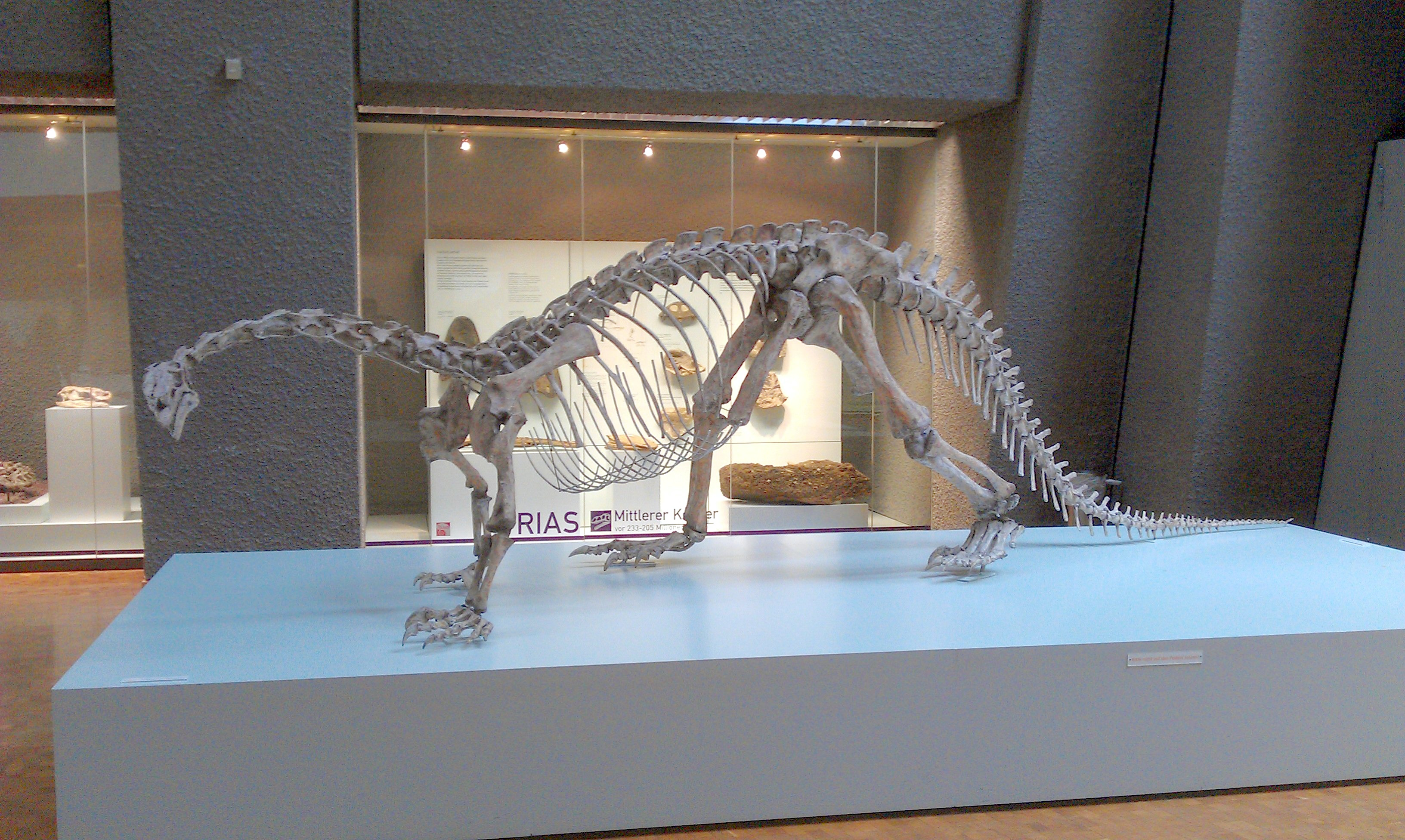 |
|
Skeleton (discovered in Trossingen) and reconstructions of Plateosaurus engelhardti on display
in the Naturkunde (in English Natural History) Museum of Stuttgart. Images credit: these photos made by the author of this website during his visit of the Museum in 2014. |
|
Products and associated philatelic items
| First-Day-of-Issue Postmarks | ||
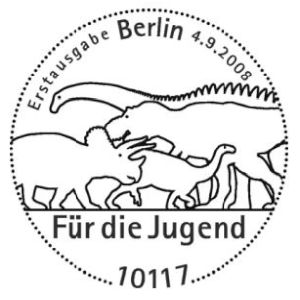 |
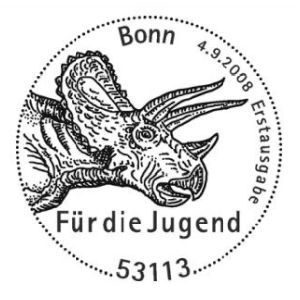 |
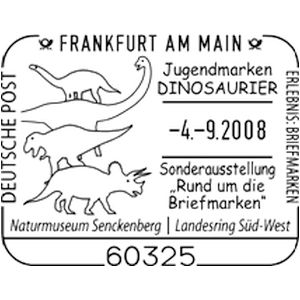 |
| Addition to commemorative postmark of Bonn and Berlin the Deutsche Philatelisten-Jugend e.V. (in English German Youth Philatelists club) produced its own commemorative postmark. The Postmark of Berlin was used on the official FDC of Deutsche Post, while the Postmark of Bonn was used on the First Day Sheet and a postmark for the museum was used on covers produced by the museum, as well as to cancel the Johann Christian Senckenberg stamp in the Souvenir Folder, produced by Deutsche Post. | ||
| Additional Commemorative Postmarks | ||
| These additional commemorative postmarks were issued by the German Youth Philatelists club for the "Day of Youth Stamps Friends" they organizied on the day of the stamps issues in several locations across Germany. | ||
| "Diplodocus. Nature history museum of Humbolt University in Berlin" | "Tyrannosaurus. Herold-Center in Norderstedt" | "Plateosaurus. Sparkasse Herfoldt" |
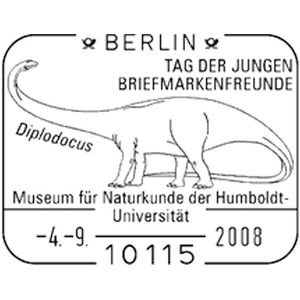 |
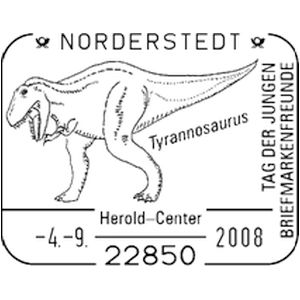 |
 |
| Official FDCs ("Deutsche Post" and "Stiftung Deutsche Jugendmarke e.V.") | FDC like covers of "Deutsche Philatelisten-Jugend e.V." | |
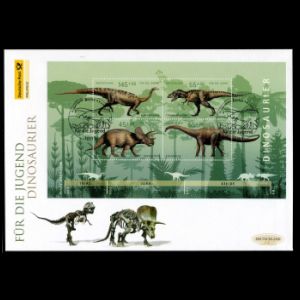 |
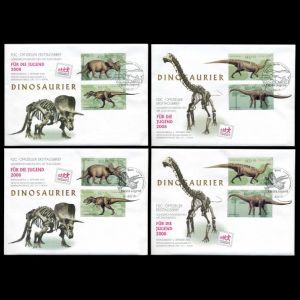 |
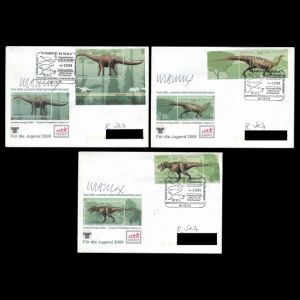 |
- Official FDC of Deutsche Post is large enough to exhibit the entire cancelled Mini-Sheet.
- Two different, small covers were issued by "the German Youth-Stamps Foundation", with the tails of the dinosaurs painted on the covers. These covers had 2 stamps from the set on each cover and a cachet depicting the skeleton of either Triceratops or Diplodocus. One set of the covers were cancelled with the Berlin postmark, the other set with the Bonn one.
- "Deutsche Philatelisten-Jugend e.V." club produced their own commemorative covers with reproduction of the stamps on the cachet with the logos of the club and the German Youth-Stamps Foundation underneath.
| Some personalized FDCs
Many more FDC, with individual stamps or the entire Mini-Sheet, were produced by dealers, philatelic societies and collectors. |
||
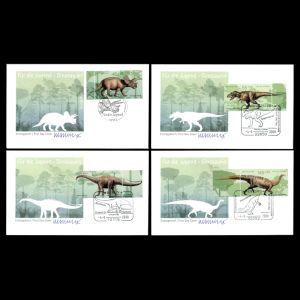 |
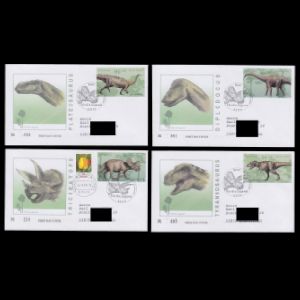 |
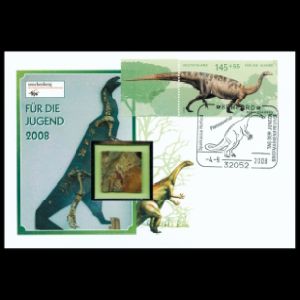 |
| "The Artist FDC" was signed by Werner Hans Schmidt, who designed 3 of the 4 stamps and both FDC postmarks. | The FDC with a piece of dinosaur coprolite (fossilized feces) in a plastic capsule, as claimed by the company who produced the cover. | |
| First Day Sheet | Color variations | Postal stationery, issued on 26.10.2008 |
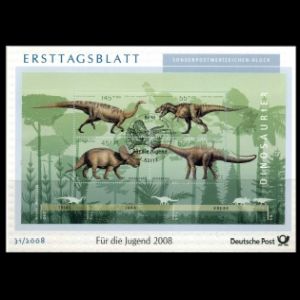 |
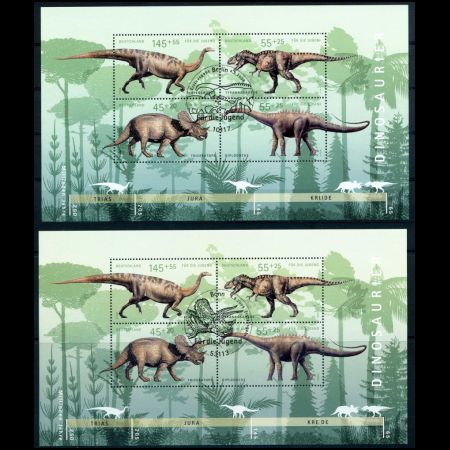 |
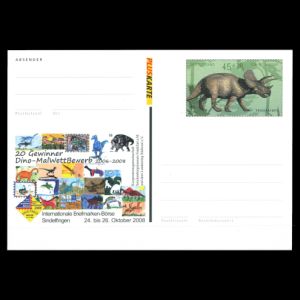 |
| Souvenirs and commemorative materials | ||
| Souvenir Booklet | Souvenir Booklet with images of some drafts | Souvenir Booklet of Deutsche Post |
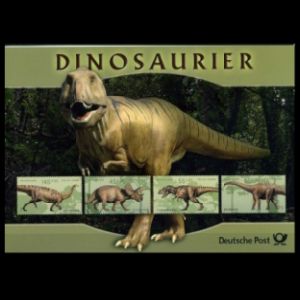 |
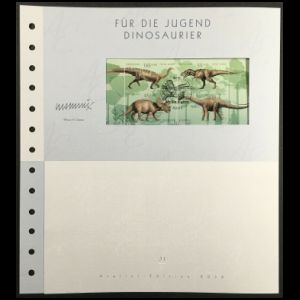 |
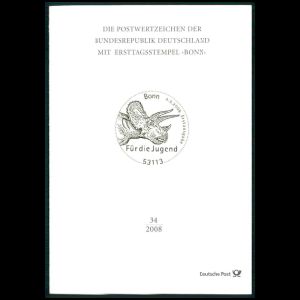 |
| Presentation cards of organiazions who was involved in the stamps issue | ||
| German Federal Ministry of Finance |
"Family, Seniors, Women and Youth" Ministry | Deutsche Post |
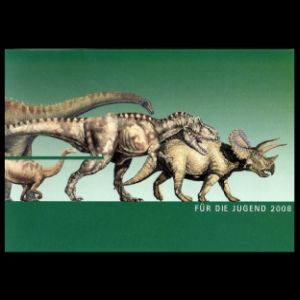 |
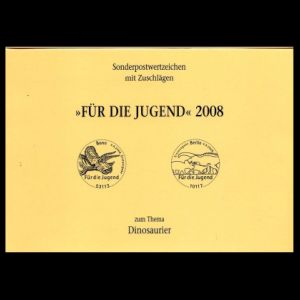 |
 |
|
The card was signed by the Minister Mr. Peer Steinbrück. The mounted Mini-Sheet was cancelled by Berlin first day of issue postmark. |
The card was signed by the Minister Dr. Ursula von der Leyen. The mounted Mini-Sheet was cancelled by Bonn first day of issue postmark. |
The card was signed by Dr. Frank Appel, the CEO of Deutsche .
|
| Printed materials related to the stamps | ||
| "Bildung + Briefmarke, Thema Dinosaurier" | "Saurier, Geheinmisvolle Urzeittiere" | "Den Dinosauriern auf der Spur" |
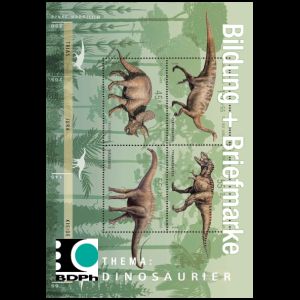 |
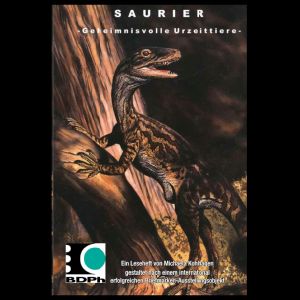 |
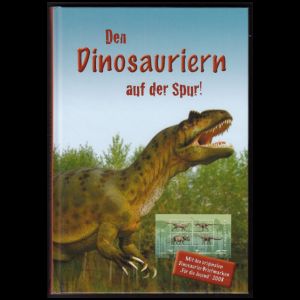 |
| Example of circulated covers | ||
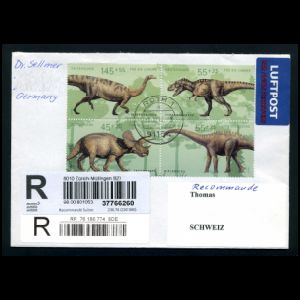 |
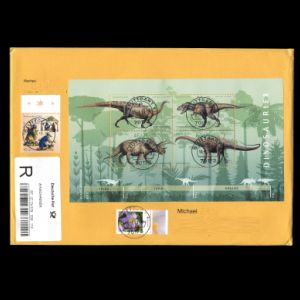 |
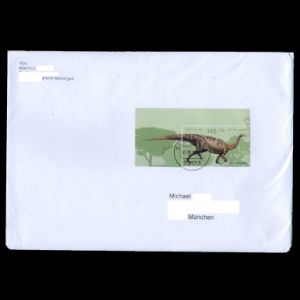 |
| Dinosaur stamps of Germany 2008 on a registered letter to Switzerland | Mini-Sheet with Dinosaur stamps of Germany 2008 on a big domestic registered letter | Plateosaurus stamp from the dinosaurs Mini-Sheet of Germany 2008 on a regular large size, domestic letter |
| Some commemorative Postmarks associated with the stamps, issued on other dates | ||
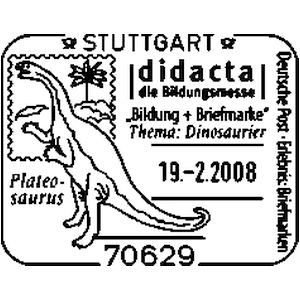 |
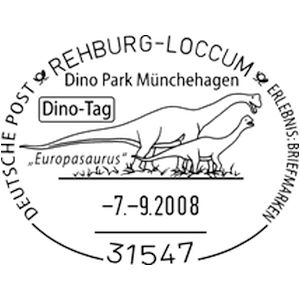 |
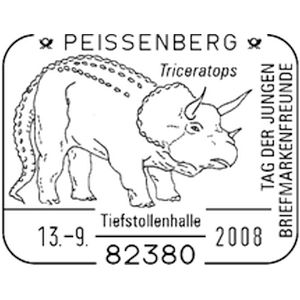 |
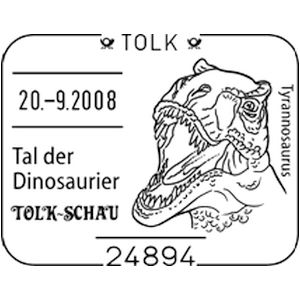 |
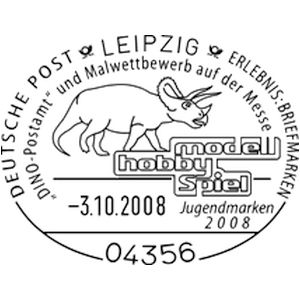 |
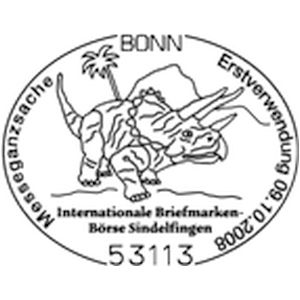 |
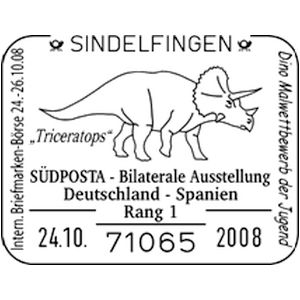 |
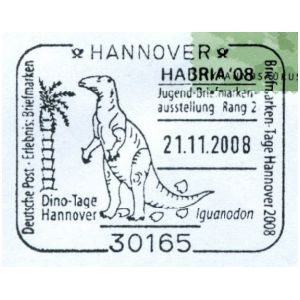 |
|
References

|
-
Technical details and stamps presentation:
First-Day-Sheet, Flyer attached to FDC, colnect, briefmarken-forum.com.
- Glückauf Nr.107, October 2008, list of the Mini-Sheet and associated postmarks. p. 56, p.60
- "Senckenberg 2007-2008" brochure of the Senckenberg Natural History Museum.
- "Süd-West Aktuell", Nr. 224 from December 2006, issued by Landesverband Südwestdeutscher Briefmarkensammler-Vereinee.V.
Printed materials -
Stamps design:
- Werner Hans Schmidt (Wikipedia)
Artists - The Federal Minister of Finance of Germany:
"Meaning of stamps", "How stamps are created", "Help out with stamps" (the "plus" stamps). - Deutsche Post
- Die Stiftung Deutsche Jugendmarke e.V. (in English "the German Youth-Stamps Foundation")
- Deutsche Philatelisten-Jugend e.V. (in English German Youth Philatelists club)
Organizations involved in the stamps release - Stamps presentation and special events:
- "DINO - MalWettBewerb 2006/2007"
Briefmarken Suedwest, - kressl.de (the website doesn't exist anymore) - the website of Mrs. Nicolette Kressl who was the Parliamentary State Secretary to the Federal Minister of Finance at the stamps issue time - "Tyrannosaurus & Co. auf Briefmarken: Staatssekretärin Nicolette Kressl stellte die Serie 'Für die Jugend 2008' vor"
- Glückauf Nr.108, Februry 2009, "Dino-Tage in Frankfurt", p. 99
- "DINO - MalWettBewerb 2006/2007"
-
The Natural History Senckenberg in Frankfurt am Main:
official website, Wikipedia, museen-in-hessen, Wikipedia,- Glückauf Nr.103, June 2007, "Naturmuseum Senckenberg/Frankfurt a.M" p. 67-68
Dinosaurs on the stamps:
|
General information about dinosaurs:
|
Acknowledgements:
- Many thanks to Dr. Peter Voice, PhD Department of Geological and Environmental Sciences, Western Michigan University, USA, for review of a draft of this article and his very valuable comments
- Many thanks to the fellow collector Mr. Rudolf Hofer from Switzerland, for sharing his photos from the stamps presentation in the Natural History Senckenberg in Frankfurt am Main.
| <prev | back to index | next> |

